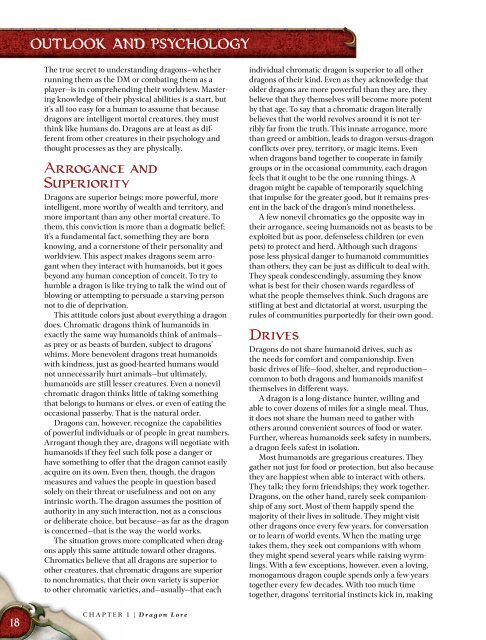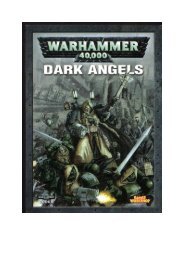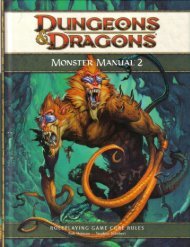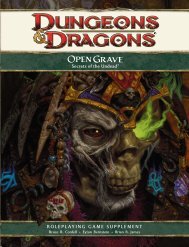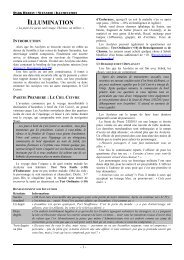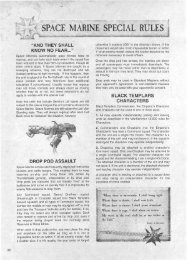You also want an ePaper? Increase the reach of your titles
YUMPU automatically turns print PDFs into web optimized ePapers that Google loves.
OUTLOOK AND PSYCHOLOGYThe true secret to understanding <strong>dragons</strong>—whetherrunning them as the DM or combating them as aplayer—is in comprehending their worldview. Masteringknowledge of their physical abilities is a start, butit’s all too easy for a human to assume that because<strong>dragons</strong> are intelligent mortal creatures, they mustthink like humans do. Dragons are at least as differentfrom other creatures in their psychology andthought processes as they are physically.Arrogance andSuperiorityDragons are superior beings: more powerful, moreintelligent, more worthy of wealth and territory, andmore important than any other mortal creature. Tothem, this conviction is more than a dogmatic belief;it’s a fundamental fact, something they are bornknowing, and a cornerstone of their personality andworldview. This aspect makes <strong>dragons</strong> seem arrogantwhen they interact with humanoids, but it goesbeyond any human conception of conceit. To try tohumble a dragon is like trying to talk the wind out ofblowing or attempting to persuade a starving personnot to die of deprivation.This attitude colors just about everything a dragondoes. Chromatic <strong>dragons</strong> think of humanoids inexactly the same way humanoids think of animals—as prey or as beasts of burden, subject to <strong>dragons</strong>’whims. More benevolent <strong>dragons</strong> treat humanoidswith kindness, just as good-hearted humans wouldnot unnecessarily hurt animals—but ultimately,humanoids are still lesser creatures. Even a nonevil<strong>chromatic</strong> dragon thinks little of taking somethingthat belongs to humans or elves, or even of eating theoccasional passerby. That is the natural order.Dragons can, however, recognize the capabilitiesof powerful individuals or of people in great numbers.Arrogant though they are, <strong>dragons</strong> will negotiate withhumanoids if they feel such folk pose a danger orhave something to offer that the dragon cannot easilyacquire on its own. Even then, though, the dragonmeasures and values the people in question basedsolely on their threat or usefulness and not on anyintrinsic worth. The dragon assumes the position ofauthority in any such interaction, not as a consciousor deliberate choice, but because—as far as the dragonis concerned—that is the way the world works.The situation grows more complicated when <strong>dragons</strong>apply this same attitude toward other <strong>dragons</strong>.Chromatics believe that all <strong>dragons</strong> are superior toother creatures, that <strong>chromatic</strong> <strong>dragons</strong> are superiorto non<strong>chromatic</strong>s, that their own variety is superiorto other <strong>chromatic</strong> varieties, and—usually—that eachindividual <strong>chromatic</strong> dragon is superior to all other<strong>dragons</strong> of their kind. Even as they acknowledge thatolder <strong>dragons</strong> are more powerful than they are, theybelieve that they themselves will become more potentby that age. To say that a <strong>chromatic</strong> dragon literallybelieves that the world revolves around it is not terriblyfar from the truth. This innate arrogance, morethan greed or ambition, leads to dragon-versus-dragonconflicts over prey, territory, or magic items. Evenwhen <strong>dragons</strong> band together to cooperate in familygroups or in the occasional community, each dragonfeels that it ought to be the one running things. Adragon might be capable of temporarily squelchingthat impulse for the greater good, but it remains presentin the back of the dragon’s mind nonetheless.A few nonevil <strong>chromatic</strong>s go the opposite way intheir arrogance, seeing humanoids not as beasts to beexploited but as poor, defenseless children (or evenpets) to protect and herd. Although such <strong>dragons</strong>pose less physical danger to humanoid communitiesthan others, they can be just as difficult to deal with.They speak condescendingly, assuming they knowwhat is best for their chosen wards regardless ofwhat the people themselves think. Such <strong>dragons</strong> arestifling at best and dictatorial at worst, usurping therules of communities purportedly for their own good.DrivesDragons do not share humanoid drives, such asthe needs for comfort and companionship. Evenbasic drives of life—food, shelter, and reproduction—common to both <strong>dragons</strong> and humanoids manifestthemselves in different ways.A dragon is a long-distance hunter, willing andable to cover dozens of miles for a single meal. Thus,it does not share the human need to gather withothers around convenient sources of food or water.Further, whereas humanoids seek safety in numbers,a dragon feels safest in isolation.Most humanoids are gregarious creatures. Theygather not just for food or protection, but also becausethey are happiest when able to interact with others.They talk; they form friendships; they work together.Dragons, on the other hand, rarely seek companionshipof any sort. Most of them happily spend themajority of their lives in solitude. They might visitother <strong>dragons</strong> once every few years, for conversationor to learn of world events. When the mating urgetakes them, they seek out companions with whomthey might spend several years while raising wyrmlings.With a few exceptions, however, even a loving,monogamous dragon couple spends only a few yearstogether every few decades. With too much timetogether, <strong>dragons</strong>’ territorial instincts kick in, making18CHAPTER 1 | Dragon Lore


